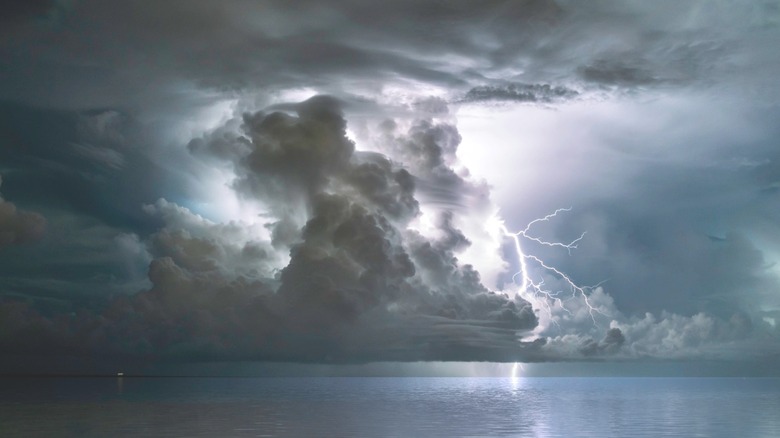How The Perfect Storm Landed Wolfgang Petersen In Hot Water
As humans we often forget that we are not really in charge like we think we are. While there are certain things that we can control, there are some that we absolutely cannot. One of those is the forces of nature. All of Earth's living creatures are at the mercy of the sun, rain or wind, and while you can prepare as best you can, sometimes there is just no way to avoid disaster.
Natural disasters and other phenomena seem to have become more frequent in modern times (per Live Science). While storms, floods, earthquakes, and tornadoes are horribly destructive and oftentimes deadly, it can almost appear that society has a morbid obsession with them. This is particularly evident when it comes to Hollywood, which cranks out disaster movies on a fairly regular basis. Films like "Twister," "The Day After Tomorrow," and even "Armageddon" are all centered on natural catastrophes and were hits at the box office. This is also true for a 2000 movie called "The Perfect Storm." However, this particular flick actually landed both its director and the studio in a sticky situation.
The disappearance of the Andrea Gail
While a lot of Hollywood movies are works of pure fiction, there are also many that are inspired by true events. The film "The Perfect Storm" was based on the tragic tale of a ship called the Andrea Gail and her disappearance at sea.
According to All That's Interesting, the fishing boat Andrea Gail set sail from Gloucester, Massachusetts on September 20, 1991. The trip was supposed to be a relatively quick one, about a month in length, with the intention of catching a load of swordfish before returning to port. Plans changed when their fishing was not initially successful and caused them to sail out further than originally intended. This choice unfortunately resulted in disaster for both the ship and her crew.
On their route back to shore, a storm was brewing. It was not just any storm, either. Remnants of Hurricane Grace had collided with a seasonal nor'easter, resulting in a massive and destructive storm. The Andrea Gail headed home on October 27 before ultimately disappearing. The ship's emergency beacon and other debris washed ashore six days later. The boat and crew were never seen again.
A controversial portrayal
Following the disappearance, a book by Sebastian Junger was published in 1997, titled "The Perfect Storm," which told the story of the Andrea Gail. In 2000, the book was adapted into a movie of the same name. The movie apparently differed in some respects from the book, which proved to be a very costly problem for the film's director, Wolfgang Petersen, and Warner Bros. Pictures.
In the film, the portrayal of the crew and especially the ship's captain, Billy Tyne, appeared to imply that Tyne and his crew sailed head-on into a storm they knew was dangerous (per All That's Interesting). Since no one from the fishing boat survived, that's pure speculation — there is of course nothing to indicate that this was the case. Due to this fact, two ex-wives of the missing crew members, along with a fisherman who was briefly portrayed in the film, sued Warner Bros., alleging the studio violated their rights of publicity and privacy. They believed the studio did not portray their loved ones fairly, and had no right to make the movie without obtaining their permission. They also wanted to be compensated (per Variety). As often happens in Hollywood, the film had been based on an actual event, with fictional elements added. Ultimately the lawsuit was unsuccessful, and was dismissed in 2003, effectively resulting in a win for the moviemakers.


